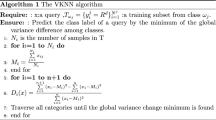Abstract
Nearest neighbor (NN) learning algorithms, examples of the lazy learning paradigm, rely on a distance function to measure the similarity of testing examples with the stored training examples. Since certain attributes are more discriminative, while others can be less or totally irrelevant, attributes should be weighed differently in the distance function. Most previous studies on weight setting for NN learning algorithms are empirical. In this paper we describe our attempt on deciding theoretically optimal weights that minimize the predictive error for NN algorithms. Assuming a uniform distribution of examples in a 2-d continuous space, we first derive the average predictive error introduced by a linear classification boundary, and then determine the optimal weight setting for any polygonal classification region. Our theoretical results of optimal attribute weights can serve as a baseline or lower bound for comparing other empirical weight setting methods.
Similar content being viewed by others
References
Aha, D. W. (1989). Incremental, instance-based learning of independent and graded concept descriptions. In Proceedings of the 1989 International Workshop on Machine Learning, pp. 387–391. Irvine, CA: Morgan Kaufmann.
Aha, D. W. & Bankert, R. L. (1994). Feature selection for case-based classification of cloud types: An empirical comparison. In Aha, D. W. (ed.), Proceedings of the AAAI-94 Workshop on Case-Based Reasoning (Technical Report WS–94–01), Menlo Park, CA: AAAI Press.
Aha, D. W., Kibler, D. & Albert, M. K. (1991). Instance-based learning algorithms. Machine Learning, 6: 37–66.
Albert, M. K. & Aha, D. W. (1991). Analyses of instance-based learning algorithms. In Proceedings of the Ninth National Conference on Artificial Intelligence, pp. 553–558. Menlo Park, CA: AAAI Press.
Cardie, C. (1993). Using decision trees to improve case-based learning. In Proceedings of the Tenth International Conference on Machine Learning, pp. 25–32. Morgan Kaufmann, San Mateo, CA.
Caruana, R. & Freitag, D. (1994). Greedy attribute selection. In Proceedings of the 1994 International Conference on Machine Learning, pp. 28–36. Morgan Kaufmann, CA.
Char, B., Geddes, K., Gonnet, G., Leong, B., Monagan, M. & Watt S. M. (1992). First Leaves: A Tutorial Introduction to Maple V. Springer-Verlag and Waterloo Maple Publishing.
Cost, S. & Salzberg, S. (1993). A weighted nearest neighbor algorithm for learning with symbolic features. Machine Learning 10: 57–78.
Cover, T. (1968). Estimation by the nearest neighbor rule. IEEE Transactions on Information Theory 14: 50–55.
Cover, T. & Hart, P. (1967). Nearest neighbor pattern classification. IEEE Transactions on Information Theory 13: 21–27.
Daelemans, W., Gillis, S., Durieux, G. & van den Bosch, A. (1993). Learnability and markedness in data-driven acquisition of stress. Tech. rep. ITK Research Report No. 43, Institute for Language Technology and AI (ITK), Tilburg University.
Dasarathy, B. (1991). Nearest neighbor (NN) norms: NN pattern classification techniques. Los Alamitos, CA: IEEE Computer Society Press.
Fukunaga, K. (1990). Introduction to Statistical Pattern Recognition (Second edition). Academic Press.
Kelly, J. D. & Davis, L. (1991). A hybrid algorithm for classification. In Mylopoulos, J. & Reite, R. (eds.), Proceedings of the Thirteenth International Conference on Artificial Intelligence, pp. 645–650. Morgan Kaufmann, San Mateo, CA.
Kibler, D. & Aha, D. W. (1987). Learning representative exemplars of concepts: An initial case study. In Proceedings of the 1987 International Workshop on Machine Learning, pp. 24–30. Irvine, CA: Morgan Kaufmann.
Langley, P. & Iba, W. (1993). Average-case analysis of a nearest neighbor algorithm. In Proceedings of the Thirteenth International Joint Conference on Artificial Intelligence, pp. 889–894. Morgan Kaufmann: San Mateo, CA.
Ling, C. X., Parry, J. J. & Wang, H. (1994). Deciding weights for IBL using C4.5. Submitted.
Mohri, M. & Tanaka, H. (1994). An optimal weighting criterion of case indexing for both numeric and symbolic attributes. Tech. rep. WS–94–01, Case-Based Reasoning: Papers from the 1994 Workshop. Menlo Park, CA: AAAI Press.
Moore, A. W. & Lee, M. S. (1994). Efficient algorithms for minimizing cross validation error. In Proceedings of the 1994 International Conference on Machine Learning, pp. 190–198. Morgan Kaufmann, CA.
Okamoto, S. & Satoh, K. (1995). An average-case analysis of k-nearest neighbor classifier. In Proceedings of the First International Conference on Case-Based Reasoning, pp. 253–264. Sesimbra, Portugal: Springer-Verlag.
Quinlan, J. (1986). Induction of decision trees. Machine Learning 1(1), 81–106.
Quinlan, J. (1993). C4.5: Programs for Machine Learning. Morgan Kaufmann: San Mateo, CA.
Satoh, K. & Okamoto, S. (1994). Toward PAC-learning of weights from qualitative distance information. Tech. rep. WS–94–01, Case-Based Reasoning: Papers from the 1994 Workshop. Menlo Park, CA: AAAI Press.
Skalak, D. (1994). Prototype and feature selection by sampling and random mutation hill climbing algorithms. In Proceedings of the 1994 International Conference on Machine Learning, pp. 293–301. Morgan Kaufmann, CA.
Stanfill, C. & Waltz, D. (1986). Toward memory-based reasoning. Communications of the ACM 29: 1213–1228.
Wettschereck, D. & Aha, D. (1995). Weighting features. In Proceedings of the First International Conference on Case-Based Reasoning, pp. 347–358. Sesimbra, Portugal: Springer-Verlag.
Wettschereck, D. & Dietterich, T. (1995). An experimental comparison of the nearest neighbor and nearest hyperrectangle algorithms. Machine Learning 19: 5–28.
Author information
Authors and Affiliations
Rights and permissions
About this article
Cite this article
Ling, C.X., Wang, H. Computing Optimal Attribute Weight Settings for Nearest Neighbor Algorithms. Artificial Intelligence Review 11, 255–272 (1997). https://doi.org/10.1023/A:1006560730186
Issue Date:
DOI: https://doi.org/10.1023/A:1006560730186




